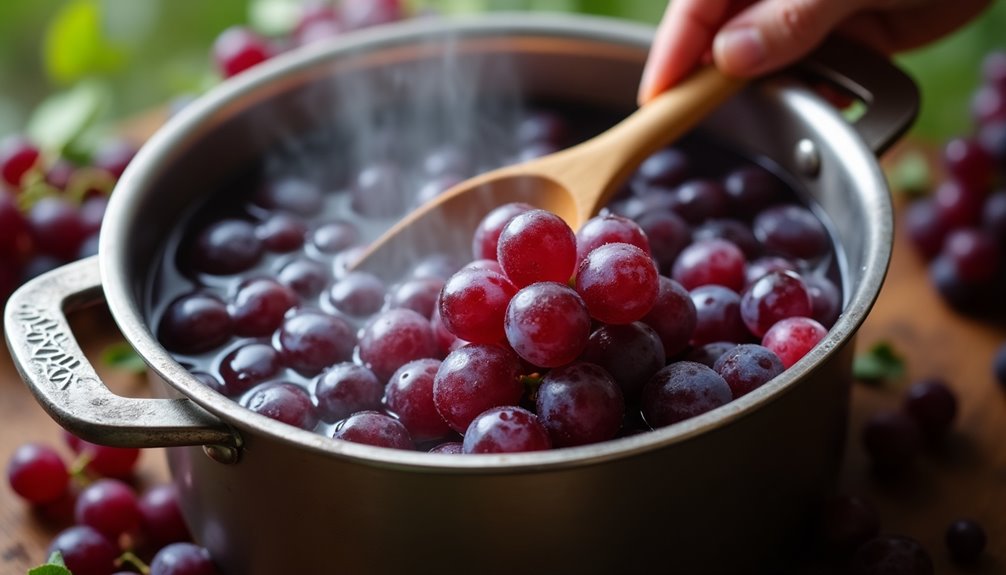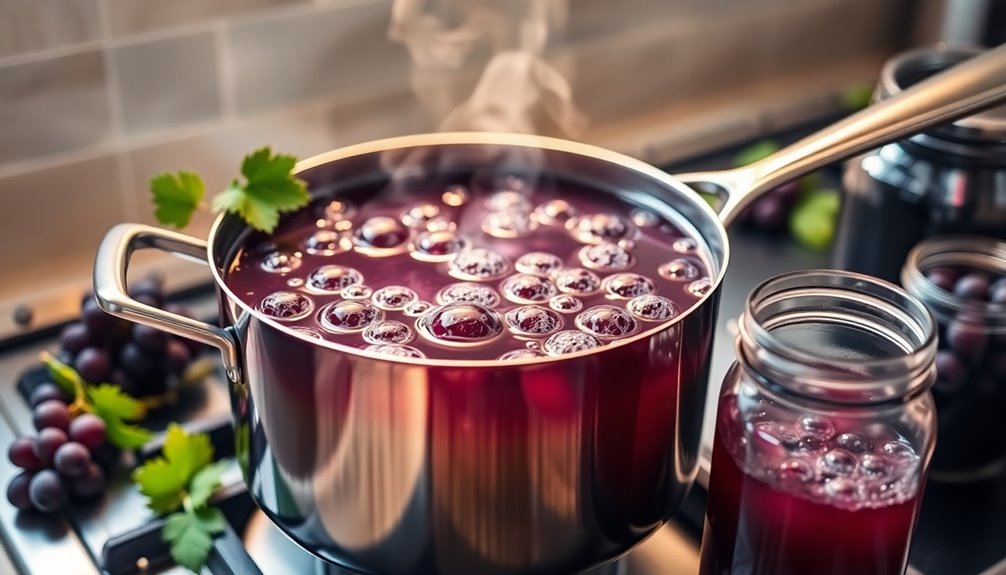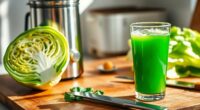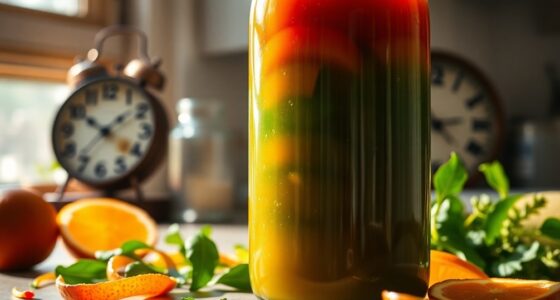To make grape juice by boiling, start with 10 pounds of well-ripened Concord grapes. Rinse them thoroughly and place them in a large pot with 2 quarts of water. Bring it to a boil and simmer for 20-30 minutes until the grapes are tender. Strain the mixture to separate the juice from solids, then sweeten with sugar to your taste. Finally, bottle the hot juice in sterilized jars to preserve it for months. There's more you can discover about perfecting this process!
Key Takeaways
- Gather 10 pounds of well-ripened Concord grapes and rinse them thoroughly to remove dirt and pesticides.
- Cook the grapes in a large pot with 2 quarts of water, simmering for 20-30 minutes until tender.
- Strain the mixture using a cloth bag or fine mesh sieve to separate the juice from the pulp and seeds.
- Return the strained juice to the pot, boil again, and add about 2 pounds of sugar, stirring until dissolved.
- Pour the hot juice into sterilized jars, seal, and process in a boiling water bath for 10 to 20 minutes for preservation.

Making your own grape juice is a rewarding and delicious way to enjoy the natural sweetness of Concord grapes. If you're ready to dive into the process of creating a batch of homemade grape juice, you'll find it's not only simple but also a fun activity that yields a tasty result. With just a few steps, you can transform fresh grapes into a refreshing beverage that you can savor all year long.
Start by gathering about 10 pounds of well-ripened Concord grapes. The quality of the grapes is crucial, as the riper they are, the sweeter your juice will be. Rinse the grapes thoroughly under cold water to remove any dirt or residual pesticides.
Once clean, place the grapes in a large stainless steel pot and add 2 quarts of water. It's time to boil! Heat the mixture over medium-high heat until it reaches a rolling boil. This process helps to soften the grapes, releasing their juices and seeds. You'll want to simmer the mixture for about 20-30 minutes, stirring occasionally, until the grapes are tender and the seeds are released.
After boiling, it's time to strain the juice. Set up a cloth bag or fine mesh sieve over a large bowl. Pour the grape mixture into the sieve, allowing the juice to flow through while the solids remain behind. This step is crucial for achieving smooth Concord grape juice. Discard the pulp and seeds, as you want only the liquid for your final product.
Once you've strained the juice, you'll have a beautiful, deep purple liquid that's full of flavor. Next, it's time to extract the juice even further. Pour the strained juice back into the pot, and bring it to a boil again. As it heats, skim off any foam that forms on the top. This step helps to clarify your homemade grape juice.
Now, to sweeten your juice, add about 2 pounds of granulated sugar. You can adjust this amount based on your taste preferences; the sugar will enhance the natural sweetness of the Concord grapes. Stir until the sugar completely dissolves. For an extra twist, consider adding a splash of lemon juice to balance the sweetness and elevate the flavor. This combination will create a delightful contrast while maintaining a richer flavor experience. Additionally, you might want to experiment by blending in a small amount of beet juice, as it can enhance the overall beet juice flavor profile and provide a vibrant color to your beverage.
Once your juice is sweetened to perfection, it's crucial to properly store it. Carefully pour the hot juice into sterilized jars, filling them to about a half-inch from the top. Seal the jars tightly with lids. To preserve your homemade grape juice, process the jars in a boiling water bath for 10 to 20 minutes. This step ensures that your juice remains safe to drink and can be stored for months.
After the boiling water bath, remove the jars and allow them to cool completely. You'll now have delicious, homemade Concord grape juice ready to enjoy! Whether you drink it straight, mix it into cocktails, or use it in recipes, you'll appreciate the effort you put into making your own juice. Enjoy the fruits of your labor!
Frequently Asked Questions
How Long to Boil Grapes for Juice?
When you're boiling grapes for juice, you'll want to simmer them for about 15 to 30 minutes.
This timeframe allows the grapes to soften and release their juices effectively. Remember, a gentle simmer is best to preserve the flavor and prevent excessive evaporation.
Keep an eye on them, stirring occasionally to avoid sticking, and ensure even cooking.
Once done, strain the mixture to separate the juice from the solids for a clear drink.
Is Boiled Grape Juice Good for Health?
Did you know that consuming boiled grape juice can provide you with about 137 calories per cup?
Yes, boiled grape juice is great for your health! It retains antioxidants and vitamins that support heart health and reduce inflammation.
Plus, the boiling process enhances the flavor and releases natural sugars, making it sweeter without extra sugar.
How to Make Grape Juice by Boiling Without Sugar?
To make grape juice without sugar, you'll need fresh Concord grapes.
Start by washing and de-stemming about 2 cups. In a pot, add enough water to barely cover the grapes, then bring it to a boil.
Lower the heat and let them simmer for 15-20 minutes, stirring occasionally.
Afterward, strain the mixture through a fine mesh sieve to separate the juice from the solids.
Cool it down, and store it in the fridge. Enjoy!
How Many Grapes Does It Take to Make a Gallon of Grape Juice?
You might think making a gallon of grape juice is as simple as picking a few grapes, but it takes about 12 to 15 pounds!
Depending on the grape variety, you'll likely get around a quart of juice from every 3 to 4 pounds.
Conclusion
In the end, making grape juice is more than just boiling fruit; it's a reminder of life's simple pleasures. Each bubbling pot mirrors our own journey, transforming raw experiences into something sweet and nourishing. As you savor that rich juice, let it symbolize the beauty of patience and the rewards of effort. Just as grapes become juice, so too can our challenges refine us, turning the ordinary into something extraordinary. Embrace the process, and enjoy the fruits of your labor.
Cindy thoroughly researches juicing trends, techniques, and recipes to provide readers with practical advice and inspiration. Her writing style is accessible, engaging, and designed to make complex concepts easy to understand. Cindy’s dedication to promoting the advantages of juicing shines through her work, empowering readers to make positive changes in their lives through the simple act of juicing.











